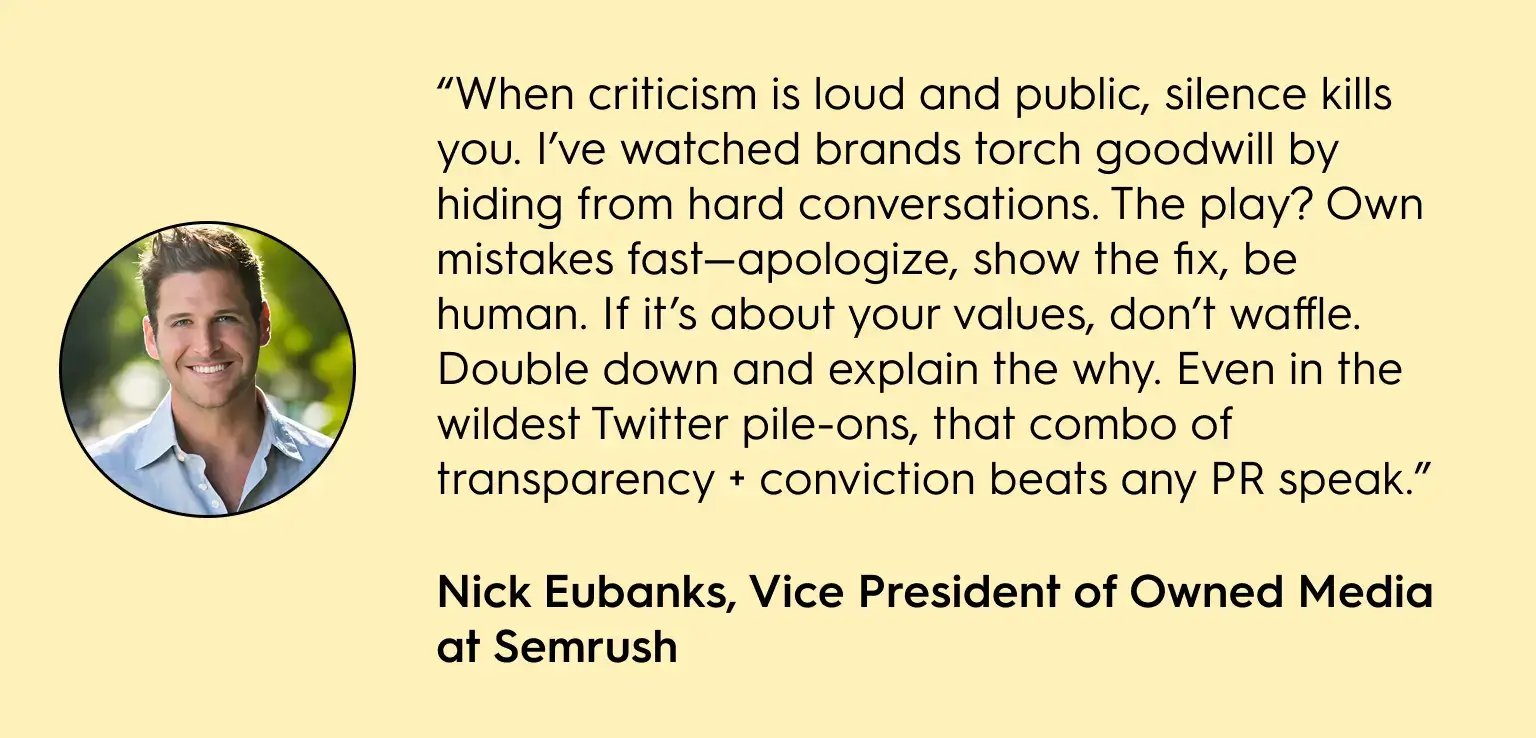What Happens When the Customer Is Brutally Honest?
%20(1).webp)
There’s a special kind of tension that only customer reviews can cause—the kind that makes a marketer hover over the refresh button like it’s a detonator. You run your campaign, optimize the flow, triple-check every CTA… and then someone named “Eunice472” casually detonates your funnel with a 1-star and a semicolon. Look, that review is not just feedback. It’s proof. And it’s public.
The thing is, brutal honesty in customer reviews isn’t the threat. Silence is. Because no reaction trains your audience to expect nothing. And that’s worse than hate—it’s irrelevance.
The companies that win don’t actually explain. They fix. Fast. In the open. With timestamps, not apologies.
So this isn’t a pep talk. It’s a field manual. You’re about to see what happens when customers stop being polite… and brands stop writing replies that sound like they were authored by legal departments.
{{form-component}}
First, Let’s Admit It: A Single Review Can Undress Your Entire Funnel
In the real economy of customer reviews, a single bad review can nuke weeks of “brand equity” in less time than it takes your CMO to find their Zoom background filter. And here’s the thing: a detailed 1-star review gets read and shared more than a stack of anonymous 5-stars with emojis. Because blunt negativity has gravity. People believe it. They pass it along. And suddenly, your attribution model looks like a crime scene.
The Math behind the Meltdown
It’s not just theory. Research from Harvard shows that for independent restaurants, a +1 star on Yelp = 5–9% revenue increase. Which means a –1 star doesn’t just sting—it rearranges quarterly forecasts. Try explaining that at a board meeting without sweating.
And you know what? Reviews aren’t evenly distributed. They’re bimodal—a J-curve pattern where most people either worship you or crucify you. The folks with “meh” experiences stay silent. So your funnel ends up defined by extremes: glowing superfans or scathing critics. Nothing in between.
Why Perfection Smells Like Perfume Samples
Now, here’s the part nobody likes to admit: perfect averages are suspicious. Across 40+ product categories, purchase likelihood actually peaks between 4.2–4.5 stars, not 5.0 (Spiegel Research). Customers want to see a little mess, a plausibly annoyed voice in the mix. Without it, your reviews read like marketing theater—and credibility evaporates.
The Response Dilemma You Can’t Shrug Off
So yes, one brutally honest review can undress your entire funnel. But the way you handle it defines whether that striptease ends in embarrassment or applause. A flat “thank you for your feedback” won’t cut it. A thoughtful negative review response (the kind that acknowledges, fixes, and shows your values) can pull you back from the edge.
Silence? Silence is reputation euthanasia.
%20(1).webp)
The “Brutality Bias” and Why It Spreads Like a Rash
Negative emotion is jet fuel. Content laced with anger, anxiety, or outrage gets shared 2.9× more than neutral or positive posts (Berger & Milkman, 2012). Which means after a bad review, it’s not the logic that spreads—it’s the sting. One customer meltdown can replicate faster than your paid campaign ever will.
“This was fine” is invisible. “This was unhinged” is viral. That’s the brutality bias at work: polite silence is boring; sharp criticism is contagious.
The Herd Effect (And Why “Mid” Never Wins)
Reviews don’t exist in isolation. A single early upvote on a review makes it 32% more likely to receive further upvotes, creating a durable herding effect that warps later ratings. So, if the first voice calls you “fraudulent,” the crowd will probably sing backup. The mean average your CFO clings to isn’t truth—it’s herd math in disguise.
That’s why review escalation is survival. Leaving one distorted negative to snowball while your team drafts a slow-motion memo is like spotting a grease fire and suggesting a committee.
Silence Is the Algorithm’s Favorite Flavor
Algorithms reward activity, not fairness. A scathing line gets liked, screenshot, reshared… while your polite negative review response sinks like a polite cough in a nightclub. And each amplification bends perception further away from the median. Which means if you’re slow to act after bad reviews, you’re training platforms to promote your worst moments.
So no, the brutality bias isn’t just human behavior. It’s baked into the platforms themselves. Brands that don’t move quickly are complicit in their own shredding.
How Fast to Respond to Reviews (The 60-Minute Damage Control Rule)
93% of customers expect brands to respond to reviews and not eventually, but now. A third expect it within 48 hours. But the companies that actually win don’t wait two days; they move within one hour when a high-signal review hits.
Why? Because delay smells like guilt. The longer the silence, the more the negative review metastasizes into a narrative. By the time your “review response policy” drafts its way through three approvals, the damage is already viral.
The DEFCON Scale of Reviews
Not all reviews are the same. A TikTok rant from “shoesandbagz91”? Manage it. A LinkedIn exec publishing a scorching post with your logo in the screenshot? That’s DEFCON 2. The review escalation process has to be crystal-clear:
- Safety breach? Legal now.
- UX blip? Ops + reply.
- Customer rage flair? Public response within an hour, plus monitoring for velocity.
- Obvious fake? Flag, don’t feed. (We’ll cover the “remove fake Google reviews” nightmare later.)
This is triage, not therapy. You don’t need a eulogy; you need speed.
Why Silence Is Fatal
As Nick Eubanks, vice president of owned media at Semrush, puts it:

This is field reporting. His words underline what every CMO secretly knows but hates to admit: a late response isn’t neutral; it’s betrayal.
The One-Hour Rule in Practice
Here’s the move: build a rapid triage protocol. Every marketer, CX lead, and ops manager needs to know who touches what in the first 60 minutes:
- Public review with teeth? Reply within the hour—acknowledge, don’t litigate.
- Positive review? Respond fast too. A lazy “thank you 🙏” won’t cut it; mirror their language and show you actually read it. Responding to positive reviews is not just etiquette—it’s retention math.
- Complicated or legal-adjacent? Escalate instantly, then reply with a timestamped holding line.
A good review response policy isn’t a PDF—it’s muscle memory.
Speed Is the Strategy
The stopwatch is always running. Delay equals guilt. A quick, human, transparent response equals control. Wait too long, and the platforms train themselves to amplify your critics instead of your corrections.
And silence isn’t absence. It’s complicity.
How to Respond to Negative Reviews
If you’re still opening with “Thank you for your feedback,” you’ve already lost. That phrase is the bland paint of brand language. It’s the copy-paste signal that says: we’re replying because Google review response etiquette demands it, not because we actually give a damn. Customers can smell that boilerplate through the screen.
The truth is simple: knowing how to respond to negative reviews is your reputation firewall. Get it right and even critics will cite you as competent. Get it wrong and your brand becomes a LinkedIn post about “tone-deaf responses.”
The Five-Part Reply Spine
Every negative review response should carry the same skeleton. Think of it as triage in public view:
- Acknowledge — Own the mistake. Don’t dilute.
- Specifics — Show you read the review, not skimmed it.
- What’s Changing — Give proof you’re fixing, not filing.
- Safe Contact Channel — A human inbox, not a ticket link.
- Public Closure — Seal the loop in the open so others see resolution.
This isn’t politeness. It’s pure math. Studies show that when businesses actively respond, they don’t just salvage credibility—they earn more reviews and higher average ratings.
Negative Review Response Examples That Don’t Sound Like Robots
Example A — Full Accountability:
“Yep, we missed it. The order stalled between systems—twice. We’ve refunded you and purged the old workflow. You’ll see a fix live by Friday. If not: sarah@ourbrand.com. No bots.”
Why it works: Direct. Transparent. Human contact included. It owns the mess without hedging.
{{cta-component}}
Example B — The Gray Area:
“We checked the logs. Our system did ping, but that doesn’t help you. So: full redo, shipped today. Also, we just updated the alert logic to prevent this loop again.”
Why it works: Even when the brand wasn’t fully at fault, it shows empathy, resolution, and improvement. Customers care less about blame, more about remedy.
The Escalation Trigger
Some reviews are indeed landmines. A safety issue requires legal + ops immediately. A spiraling thread? That’s comms + leadership. If you treat every review like an interchangeable support ticket, your review escalation process is broken.
Look, one ignored review doesn’t stay ignored. Platforms surface it, competitors screenshot it, and prospective buyers scroll right past your CTA.
Closing the Loop in Public
Once you’ve patched the problem privately, return to the review thread and confirm it publicly. That closure signals credibility to everyone else still lurking in silence. Because the critic you replied to isn’t the real audience. The 1,000 people reading silently are.
When Fake Reviews Happen: How to Remove Fake Google Reviews (Actually)
Nearly 48% of local businesses are hit by fake reviews every year. That’s half the market poisoned by bots, trolls, or competitors who’ve mistaken Google Maps for a boxing ring. One U.S. hotel audit even found that 70% of its 1-star reviews in Q4 2023 came from non-guests.
And while you’re drafting your witty negative review response, the damage is algorithmic. Google’s local ranking logic doesn’t differentiate between authentic feedback and a sock puppet vendetta.
The Actual Process
So, how do you remove fake Google reviews? Not by tweeting at Google Support, and not by praying. The actual sequence looks like this:
- Flag directly on the review — every fake starts here.
- File via your Business Profile dashboard — detail the violation: PII exposure, conflict of interest, or obvious spam.
- Document everything — screenshots, transaction logs, IP traces if you have them.
- Escalate if ignored after 7 days — Google reviews flagged en masse or backed by proof have higher odds of removal.
- Avoid replying unless it’s gone viral — the algorithm sees engagement as oxygen; don’t feed it unless you’re containing spread.
This is boring admin work, but it’s also reputation triage.
Why It Matters for Reputation Recovery
Fake negatives drag harder than they should, but authentic positive reviews can dilute their impact fast. Research shows that going from zero to five reviews lifts purchase likelihood by ~270% (Spiegel Research). So, reputation recovery is volume. The more genuine voices you surface, the faster the fakes sink into irrelevance.
Fake reviews aren’t a glitch in the system. They are the system because open platforms always attract bad actors. The brands that endure don’t waste cycles arguing with ghosts. They work the official removal pipeline, document aggressively, and double-down on amplifying the voices that are real.
Because at the end of the day, you can’t stop the fraudsters from trying. But you can make their effort irrelevant.
The Review Escalation Process: When to Loop in Legal, Ops, or the CEO
Here’s the thing: not every angry customer should be handled with a polite Google review response drafted by your community team. Some reviews are mild—it’s safe to let your frontline run with a pre-approved macro. But others are landmines. And pretending they’re all the same is how brands tank reputation recovery.
Escalation is survival.
%20(1).webp)
The Four Levels of Review Escalation
Think of it like a flowchart:
- Level 1: Community Team → Macro Reply
For routine gripes, a quick acknowledgment works. Yes, even here, you should resist the urge to just respond to positive reviews and call it a day. Macros save time, not credibility.
- Level 2: Ops Tag → Fix + Custom Reply
When the complaint is about functionality or fulfillment, ops needs to patch it, then you post the fix. This shows reviews drive real change—not just canned empathy.
- Level 3: Legal → Secure the Perimeter
Accusations of fraud, safety breaches, or anything that smells like liability? Legal’s desk, not marketing’s. Public replies here must be careful, timestamped, and airtight.
- Level 4: Exec → Public Accountability Post
If the review goes viral (or worse, climbs into press coverage), the CEO or exec sponsor has to step in. Silence from the top is the fastest way to look guilty. A short, human, public statement beats a 14-slide “brand values” deck.
The escalation ladder is insurance. The faster you route reviews to the right owner, the less chance they metastasize. Because let’s be honest: reviews don’t just test your product. They test whether your org chart knows who’s supposed to talk when it matters.
How to Ask Customers for Reviews without Sounding Desperate
Most brands ask for reviews the same way a teenager asks for rent money: awkward, needy, and instantly forgettable. If you want to know how to get more Google reviews that don’t reek of desperation, you have to quit with the “Please give us 5 stars!” grovel. Nothing screams fake faster.
The Golden Window: 15–45 Minutes
Timing isn’t “whenever.” The best moment to ask customers for reviews is right after a successful interaction—specifically within 15 to 45 minutes. Too soon? Feels automated. Too late? The dopamine of “that actually worked” is gone. Miss that window, and you’re basically spamming.
Keep It Human, Not Corporate
Strip out the corporate perfume. Don’t say “positive reviews.” Don’t hide behind vague CTAs like “Click here.” Instead, send direct links that land on the review form. If it takes more than one tap, you’re already losing.
Here’s the kind of review request email that actually lands:
Subject: You good with what happened today?
Body:
You used our [thing] on [day]. If it worked, say it. If it didn’t, drag us—publicly or here. It’s a 30-second link. We do read them.
No begging. No star-fishing. But radical brevity and honesty.
Track the Right Metrics (or Else)
Tracking matters, but not the way most teams do it. Don’t just count raw review volume; watch review velocity by rep, channel, or location. This helps you spot when one staffer is crushing it versus another who leaves customers colder than a day-old latte. It also prevents suspicious spikes that get flagged by Google’s spam filters.
Why This Works
Because desperation is detectable. Customers smell it. A confident, plainspoken request says: we back our product. A needy one says: please fix our reputation for us. The former builds credibility, the latter kills it.
And customers who feel they can be brutally honest in a review are more likely to leave one at all. Which means fewer fake-sounding “best service ever!!” blurbs, and more reviews that people actually believe.
{{form-component}}
Responding to Positive Reviews (Because “Thank You 🙏” Is Lazy)
Most customer reviews don’t come in with pom-poms and confetti. So when one actually does (glowing, specific, shockingly sincere) the worst thing you can do is reply like a parking ticket.
“Thanks for your feedback!”
Cool. Feels like it went straight into a void.
Positive reviews are a gift and a cue. A cue to mirror what they loved, signal what else they’d love, and maybe (just maybe) make them say something even better next time.
Now, here’s how actual human brands respond:
→ The Name-Dropper
“You just made Zach in QA blush. For real. He’s the one who caught that buggy submit button last week.”
→ The Invitation
“So glad the scheduling tool worked clean for you. Next time, try bulk duplication—it’s one of those features we undersell and regret it.”
→ The Callback
“Ah, the upload speed. Music to our backend team’s ears. (Shoutout to Camila, who once re-coded that widget at 1:42 a.m. during a cold front.)”
It’s not hard. And you’re not writing a eulogy here. Just respond like someone who gives a damn… and knows what else might earn the next 5-star.
Because your silence is how 5s quietly rot into 4s.












Heading 1
Heading 2
Heading 3
Heading 4
Heading 5
Heading 6
Lorem ipsum dolor sit amet, consectetur adipiscing elit, sed do eiusmod tempor incididunt ut labore et dolore magna aliqua. Ut enim ad minim veniam, quis nostrud exercitation ullamco laboris nisi ut aliquip ex ea commodo consequat. Duis aute irure dolor in reprehenderit in voluptate velit esse cillum dolore eu fugiat nulla pariatur.
Block quote
Ordered list

- Item 1
- Item 2
- Item 3
Unordered list
- Item A
- Item B
- Item C
Bold text
Emphasis
Superscript
Subscript



.webp)


%20(1).webp)

%20(1).webp)

